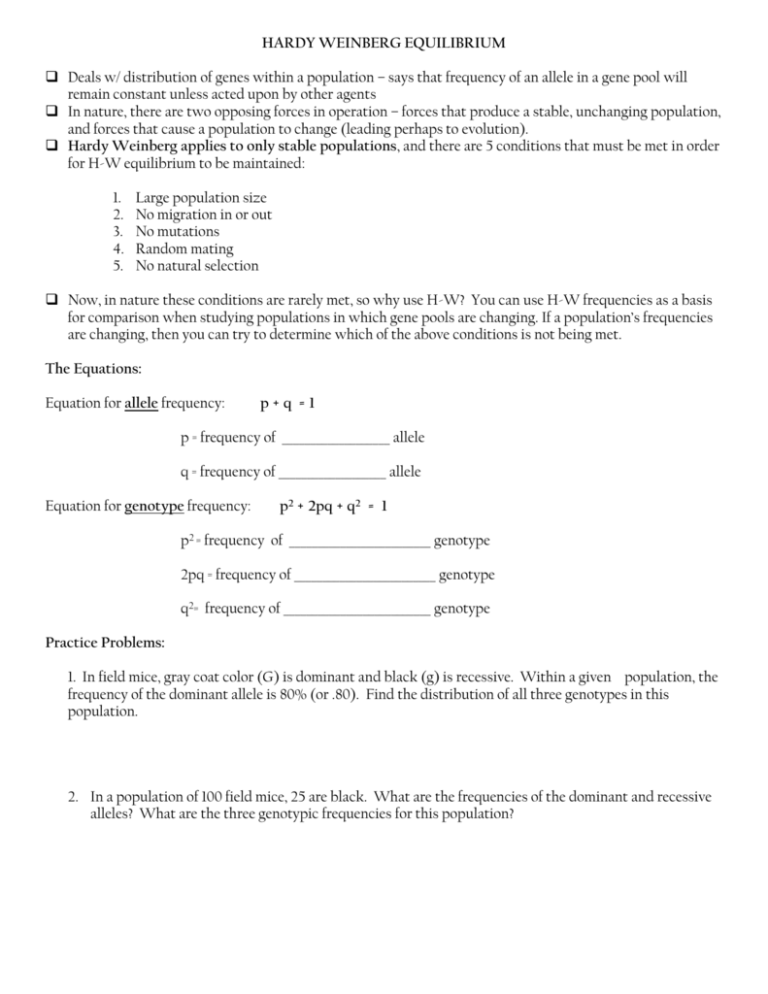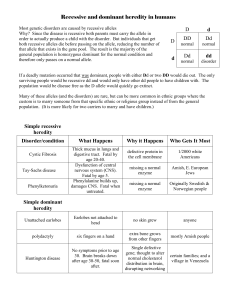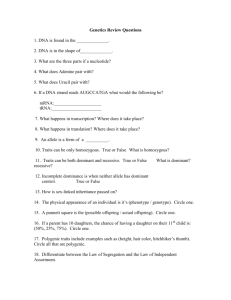hardy weinberg equilibrium
advertisement

HARDY WEINBERG EQUILIBRIUM Deals w/ distribution of genes within a population – says that frequency of an allele in a gene pool will remain constant unless acted upon by other agents In nature, there are two opposing forces in operation – forces that produce a stable, unchanging population, and forces that cause a population to change (leading perhaps to evolution). Hardy Weinberg applies to only stable populations, and there are 5 conditions that must be met in order for H-W equilibrium to be maintained: 1. 2. 3. 4. 5. Large population size No migration in or out No mutations Random mating No natural selection Now, in nature these conditions are rarely met, so why use H-W? You can use H-W frequencies as a basis for comparison when studying populations in which gene pools are changing. If a population’s frequencies are changing, then you can try to determine which of the above conditions is not being met. The Equations: Equation for allele frequency: p+q =1 p = frequency of ___________________ allele q = frequency of ___________________ allele Equation for genotype frequency: p2 + 2pq + q2 = 1 p2 = frequency of _________________________ genotype 2pq = frequency of _________________________ genotype q2= frequency of __________________________ genotype Practice Problems: 1. In field mice, gray coat color (G) is dominant and black (g) is recessive. Within a given population, the frequency of the dominant allele is 80% (or .80). Find the distribution of all three genotypes in this population. 2. In a population of 100 field mice, 25 are black. What are the frequencies of the dominant and recessive alleles? What are the three genotypic frequencies for this population? 3. If the frequency of a dominant allele is present at 60%, what will be the expected percent of the population with the hybrid genotype? 4. In a population of field mice, the frequency of the recessive allele of black coat color is present at 30%. What is the distribution of the homozygous recessive and heterozygous genotypes? 5. In a population of 400 rabbits, 300 have the dominant allele (W) for white fur. a. What is the frequency of the recessive allele (w) for black fur in this population? b. In the same population, what percentage of rabbits would be hybrid for white fur? 6. The percentage of people with free earlobes (dominant) is 84% while 16% of the people have the recessive allele. Find the distribution of all genotypes for this population. 7. In Drosophila the allele for normal-length wings is dominant over the allele for vestigial wings (tiny stubs that can’t be used for flight.) In a population of 1,000 flies, 360 show the recessive phenotype. How many individuals would you expect to be homozygous dominant? How many would you expect to be heterozygous? 8. The allele for free earlobes is dominant over the allele for attached earlobes. In a population of 500 individuals, 25% show the recessive phenotype. How many individuals would you expect to be homozygous dominant for this trait? Heterozygous? 9. The allele for the hair pattern called widow’s peak is dominant over the allele for no widow’s peak. In a population of 1,000 individuals, 510 show the dominant phenotype. How many individuals would you expect of each of the possible three genotypes for this trait?








